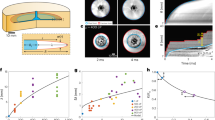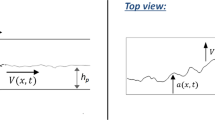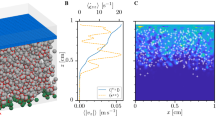Abstract
Planar crack propagation under pure tension loading (mode I) is generally stable. However, it becomes universally unstable with the superposition of a shear stress parallel to the crack front (mode III). Under this mixed-mode (I + III) loading configuration, an initially flat parent crack segments into an array of daughter cracks that rotate towards a direction of maximum tensile stress1. This segmentation produces stepped fracture surfaces with characteristic ‘lance-shaped’ markings observed in a wide range of engineering2,3,4,5,6,7 and geological materials1,8. The origin of this instability remains poorly understood and a theory with which to predict the surface roughness scale is lacking. Here we perform large-scale simulations of mixed-mode I + III brittle fracture using a continuum phase-field method9,10,11 that describes the complete three-dimensional crack-front evolution. The simulations reveal that planar crack propagation is linearly unstable against helical deformations of the crack front, which evolve nonlinearly into a segmented array of finger-shaped daughter cracks. Furthermore, during their evolution, facets gradually coarsen owing to the growth competition of daughter cracks in striking analogy with the coarsening of finger patterns observed in nonequilibrium growth phenomena12,13,14. We show that the dynamically preferred unstable wavelength is governed by the balance of the destabilizing effect of far-field stresses and the stabilizing effect of cohesive forces on the process zone scale, and we derive a theoretical estimate for this scale using a new propagation law for curved cracks in three dimensions. The rotation angles of coarsened facets are also compared to theoretical predictions and available experimental data.
This is a preview of subscription content, access via your institution
Access options
Subscribe to this journal
Receive 51 print issues and online access
$199.00 per year
only $3.90 per issue
Buy this article
- Purchase on Springer Link
- Instant access to full article PDF
Prices may be subject to local taxes which are calculated during checkout




Similar content being viewed by others
References
Pollard, D. D., Segall, P. & Delaney, P. T. Formation and interpretation of dilatant echelon cracks. Geol. Soc. Am. Bull. 93, 1291–1303 (1982)
Smekal, A. Zum Bruchvorgang bei sprödem Stoffverhalten unter ein-und mehrachsigen Beanspruchungen. Oesterr. Ing. Arch. 7, 49–70 (1953)
Sommer, E. Formation of fracture ‘lances’ in glass. Eng. Fract. Mech. 1, 539–546 (1969)
Yates, J. R. & Miller, K. J. Mixed mode (I+III) fatigue thresholds in a forging steel. Fatigue Fract. Eng. Mater. Struct. 12, 259–270 (1989)
Cooke, M. L. & Pollard, D. D. Fracture propagation paths under mixed mode loading within rectangular blocks of polymethyl methacrylate. J. Geophys. Res. 101, 3387–3400 (1996)
Momber, A. W. Fracture lances in glass loaded with spherical indenters. J. Mater. Sci. Lett. 22, 1477–1481 (2003)
Lazarus, V., Buchholz, F.-G., Fulland, M. & Wiebesiek, J. Comparison of predictions by mode II or mode III criteria on crack front twisting in three or four point bending experiments. Int. J. Fract. 153, 141–151 (2008)
DeGraff, J. M. & Aydin, A. Surface morphology of columnar joints and its significance to mechanics and direction of joint growth. Geol. Soc. Am. Bull. 99, 605–617 (1987)
Karma, A., Kessler, D. A. & Levine, H. Phase-field model of mode III dynamic fracture. Phys. Rev. Lett. 87, 045501 (2001)
Hakim, V. & Karma, A. Crack path prediction in anisotropic brittle materials. Phys. Rev. Lett. 95, 235501 (2005)
Hakim, V. & Karma, A. Laws of crack motion and phase-field models of fracture. J. Mech. Phys. Solids 57, 342–368 (2009)
Langer, J. S. Dendrites, viscous fingers, and the theory of pattern formation. Science 243, 1150–1156 (1989)
Ben-Jacob, E. & Garik, P. The formation of patterns in non-equilibrium growth. Nature 343, 523–530 (1990)
Trivedi, R., Liu, S. & Williams, S. Interface pattern formation in nonlinear dissipative systems. Nature Mater. 1, 157–159 (2002)
Fineberg, J., Gross, S. P., Marder, M. & Swinney, H. L. Instability in dynamic fracture. Phys. Rev. Lett. 67, 457–460 (1991)
Marder, M. & Gross, S. Origin of crack tip instabilities. J. Mech. Phys. Solids 43, 1–48 (1995)
Fineberg, J. & Marder, M. Instability in dynamic fracture. Phys. Rep. 313, 1–108 (1999)
Sharon, E., Cohen, G. & Fineberg, J. Propagating solitary waves along a rapidly moving crack front. Nature 410, 68–71 (2001)
Buehler, M. J. & Gao, H. Dynamical fracture instabilities due to local hyperelasticity at crack tips. Nature 439, 307–310 (2006)
Freund, L. B. Dynamic Fracture Mechanics (Cambridge University Press, 1998)
Gao, H. & Rice, J. R. Shear stress intensity factors for a planar crack with slightly curved front. J. Appl. Mech. 53, 774–778 (1986)
Lazarus, V., Leblond, J.-B. & Mouchrif, S.-E. Crack front rotation and segmentation in mixed mode I+III or I+II+III. Part II: Comparison with experiments. J. Mech. Phys. Solids 49, 1421–1443 (2001)
Karma, A. in Handbook of Materials Modeling (ed. Yip, S.) 2087–2103 (Springer, 2005)
Xu, G., Bower, A. F. & Ortiz, M. An analysis of non-planar crack growth under mixed mode loading. Int. J. Solids Struct. 31, 2167–2193 (1994)
Goldstein, R. V. & Salganik, R. L. Brittle fracture of solids with arbitrary cracks. Int. J. Fract. 10, 507–523 (1974)
Eshelby, J. D. The elastic energy-momentum tensor. J. Elast. 5, 321–335 (1975)
Bouchbinder, E., Livne, A. & Fineberg, J. Weakly nonlinear theory of dynamic fracture. Phys. Rev. Lett. 101, 264302 (2008)
Meakin, P. Fractals, Scaling and Growth Far from Equilibrium (Cambridge University Press, 1998)
Yuse, A. & Sano, M. Transition between crack patterns in quenched glass plates. Nature 362, 329–331 (1993)
Acknowledgements
We thank V. Hakim, J.-B. Leblond and V. Lazarus for discussions and references to the literature. This work was supported by US DOE grant number DE-FG02-07ER46400. A.J.P. also acknowledges support of grant numbers EX2005-0085 and FIS2009-13360-C03-02 and the Juan de la Cierva Program of the Spanish Ministry of Science and Innovation.
Author Contributions Both authors contributed equally to this work.
Author information
Authors and Affiliations
Corresponding author
Ethics declarations
Competing interests
The authors declare no competing financial interests.
Supplementary information
Supplementary Information
This file contains Supplementary Information, a Supplementary Explanation to Supplementary Movies 1-3, Supplementary Data, Supplementary Figure S1 with Legend and Supplementary References. (PDF 836 kb)
Supplementary Movie 1
This movie (frontal.mov) shows the frontal view of the propagating crack-front that produced the fracture surfaces that are displayed at different times in Fig. 1(c-d) of the article. (MOV 352 kb)
Supplementary Movie 2
This movie (lateral.mov) shows lateral view of the propagating crack-front that produced the fracture surfaces that are displayed at different times in Fig. 1(c-d) of the article. (MOV 380 kb)
Supplementary Movie 3
This movie (helical.mov) is an animation of Fig. 2(a) that highlights the helical nature of the crack-front instability. (MOV 807 kb)
Rights and permissions
About this article
Cite this article
Pons, A., Karma, A. Helical crack-front instability in mixed-mode fracture. Nature 464, 85–89 (2010). https://doi.org/10.1038/nature08862
Received:
Accepted:
Issue Date:
DOI: https://doi.org/10.1038/nature08862
This article is cited by
-
Propagation of extended fractures by local nucleation and rapid transverse expansion of crack-front distortion
Nature Physics (2024)
-
Complexity of crack front geometry enhances toughness of brittle solids
Nature Physics (2024)
-
Revisiting facet nucleation under mixed mode I + III loading with T-stress and mode-dependent fracture properties
International Journal of Fracture (2023)
-
Potential fracture configurations of a cracked solid under mixed mode-I/III loading
Archive of Applied Mechanics (2023)
-
Irreversible phase field models for crack growth in industrial applications: thermal stress, viscoelasticity, hydrogen embrittlement
SN Applied Sciences (2021)
Comments
By submitting a comment you agree to abide by our Terms and Community Guidelines. If you find something abusive or that does not comply with our terms or guidelines please flag it as inappropriate.



